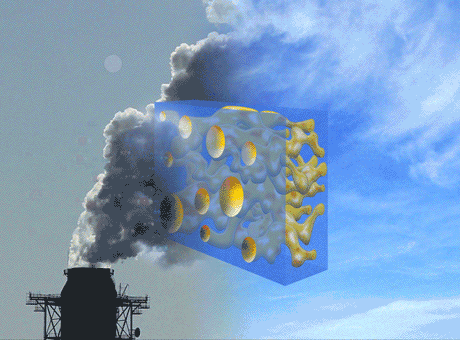Aug 5 2016
 Nano sponges that fight climate change. (Credit: Lawrence Berkeley National Laboratory)
Nano sponges that fight climate change. (Credit: Lawrence Berkeley National Laboratory)
The science of the extremely small is being used by researchers from the Berkeley Lab to resolve big challenges.
Given below are five ongoing projects that have recently gained spotlight in the news center, which promise major results derived from extremely small building blocks:
A DIY Paint-On Coating for Energy-Efficient Windows
This do it yourself retrofit tech is capable of enhancing the energy efficiency of windows and saving money. Currently, researchers are working to produce a polymer-based heat-reflective coating that uses a polymer’s odd-looking molecular architecture.
This retrofit tech has the potential to be painted on windows at one-tenth the cost of the existing retrofit approaches. The window films that are commercially available today reflect infrared solar energy back to the sky while permitting visible light to travel through.
However, a professional contractor is required to execute the installation process. A relatively inexpensive option could expand adoption and lead to possible annual energy savings equivalent to removing 5 million cars off the road.
Nanowires That Move Data at Light Speed
A new method to develop nanoscale wires that can assist as tiny, tunable lasers has been discovered by researchers. The outstanding performance of these lasers is ideal for the field of optoelectronics, which focuses on integrating light and electronics for transmitting data, among various other applications.
The concept of miniaturizing lasers to the nanoscale will further help to modernize computing, introducing light-speed data transmission to desktop, and eventually, handheld computing devices.
Nano Sponges That Fight Climate Change
Nano sponges are being produced by scientists in order to obtain carbon from power plants before it comes into the atmosphere. Preliminary tests highlight that the hybrid membrane, made up of nano-sized cages known as metal-organic frameworks, and a polymer, is eight times more carbon dioxide permeable compared to membranes comprising of only the polymer.
Enhancing carbon dioxide permeability seems to be a primary goal as part of the ongoing efforts to produce carbon capture materials that are cost competitive and efficient.
Custom-Made Chemical Factories
Recently, scientists redesigned a building block of a nanocompartment that exists naturally in bacteria, majorly increasing the potential of nanocompartments to be used as custom-made chemical factories. Researchers are planning to customize this new application in order to develop medicines and other high-value chemical products on demand.
Several copies of just three varied kinds of proteins are used to develop the firm nanocompartments. Bacterial microcompartments, the natural counterparts of the nanocompartments, cover a wide range of enzymes capable of executing highly specialized chemistry in bacteria.
Nanotubes That Assemble Themselves
A family of nature-inspired polymers has been discovered by researchers. When inserted in water, these polymers spontaneously arrange themselves into hollow crystalline nanotubes. These nanotubes can also be tuned such that all comprise the same diameter ranging between five and ten nanometers.
Scientists can monitor what goes through by being able to control the diameter of nanotubes and the chemical groups exposed in the interior of the nanotubes. Nanotubes prove to be immensely useful as they can be effectively used for delivering cancer-fighting drugs, desalinating seawater and many other applications.
The Science of Small Revealed Using a Penny
The video below illustrates how small nanoscience can get by presenting an example of using an American penny from the Molecular Foundry.
SF Cleantech Pitchfest: Nano Sponges for Carbon Capture
Video Credit: Berkeley Lab/Youtube.com
This video shows how the letters that spell Molecular Foundry were written with a beam of electrons fired at the surface. The smallest feature is 20 nanometers, or approximately around 100 atoms. The display of the Molecular Foundry disappears as the Molecular Foundry, and the Berkeley Lab logo is seen.
A beam of charged gallium atoms was used to write the logo. An 18 hour time lapse of Abraham Lincoln’s face written with gallium atoms is seen again as the zooming out continues. All of this is finally executed within the Lincoln Memorial side of the penny as it is made to move from the focused ion beam.
Photolithography, also referred to as writing with light, is the basis for most top-down fabrication of things such as microprocessors. Photolithography is not used for devices that have features no smaller than the wavelength of the light that is used, often in the 100s of nanometers. Things smaller than light, such as electrons and atoms must be used.
Source: http://universityofcalifornia.edu/